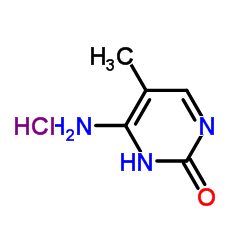5-METHYLCYTOSINE HYDROCHLORIDE

5-METHYLCYTOSINE HYDROCHLORIDE structure
|
Common Name | 5-METHYLCYTOSINE HYDROCHLORIDE | ||
|---|---|---|---|---|
| CAS Number | 58366-64-6 | Molecular Weight | 161.589 | |
| Density | N/A | Boiling Point | N/A | |
| Molecular Formula | C5H8ClN3O | Melting Point | 293-295°C effervescence | |
| MSDS | USA | Flash Point | N/A | |
|
Electrospray ionization mass spectrometry of non-covalent complexes formed between N-alkylimidazolium-containing zwitterionic sulfonates and protonated bases.
Eur. J. Mass Spectrom. (Chichester, Eng.) 20(6) , 467-75, (2015) This paper describes non-covalent complexes between zwitterionic 3-(1-alkyl-3N-imidazolio)- propane-1-sulfonates and different amines. Electrospray ionization (ESI) mass spectrometry and collision- induced dissociation were used to measure the stability of su... |
|
|
Crystal structure of TET2-DNA complex: insight into TET-mediated 5mC oxidation.
Cell 155(7) , 1545-55, (2013) TET proteins oxidize 5-methylcytosine (5mC) on DNA and play important roles in various biological processes. Mutations of TET2 are frequently observed in myeloid malignance. Here, we present the crystal structure of human TET2 bound to methylated DNA at 2.02_... |
|
|
3-D DNA methylation phenotypes correlate with cytotoxicity levels in prostate and liver cancer cell models.
BMC Pharmacol. Toxicol. 14 , 11, (2013) The spatial organization of the genome is being evaluated as a novel indicator of toxicity in conjunction with drug-induced global DNA hypomethylation and concurrent chromatin reorganization. 3D quantitative DNA methylation imaging (3D-qDMI) was applied as a ... |
|
|
Electrochemical DNA methylation detection for enzymatically digested CpG oligonucleotides.
Anal. Chem. 83(20) , 7595-9, (2011) We describe the electrochemical detection of DNA methylation through the direct oxidation of both 5-methylcytosine (mC) and cytosine (C) in 5'-CG-3' sequence (CpG) oligonucleotides using a sputtered nanocarbon film electrode after digesting a longer CpG oligo... |
|
|
Dynamic changes in 5-hydroxymethylation signatures underpin early and late events in drug exposed liver.
Nucleic Acids Res. 41(11) , 5639-54, (2013) Aberrant DNA methylation is a common feature of neoplastic lesions, and early detection of such changes may provide powerful mechanistic insights and biomarkers for carcinogenesis. Here, we investigate dynamic changes in the mouse liver DNA methylome associat... |
|
|
DNA recognition of 5-carboxylcytosine by a Zfp57 mutant at an atomic resolution of 0.97 Å.
Biochemistry 52(51) , 9310-7, (2013) The Zfp57 gene encodes a KRAB (Krüppel-associated box) domain-containing C2H2 zinc finger transcription factor that is expressed in early development. Zfp57 protein recognizes methylated CpG dinucleotide within GCGGCA elements at multiple imprinting control r... |
|
|
Ascorbate-induced generation of 5-hydroxymethylcytosine is unaffected by varying levels of iron and 2-oxoglutarate.
Biochem. Biophys. Res. Commun. 439(4) , 522-7, (2013) Tet (ten-eleven translocation) methylcytosine dioxygenases, which belong to the iron and 2-oxoglutarate (2OG)-dependent dioxygenase superfamily, convert 5-methylcytosine (5mC) to 5-hydroxymethylcytosine (5hmC) in DNA. We recently reported that ascorbate (vita... |
|
|
Quantitative assessment of Tet-induced oxidation products of 5-methylcytosine in cellular and tissue DNA.
Nucleic Acids Res. 41(13) , 6421-9, (2013) Recent studies showed that Ten-eleven translocation (Tet) family dioxygenases can oxidize 5-methyl-2'-deoxycytidine (5-mdC) in DNA to yield the 5-hydroxymethyl, 5-formyl and 5-carboxyl derivatives of 2'-deoxycytidine (5-HmdC, 5-FodC and 5-CadC). 5-HmdC in DNA... |
|
|
Discovery of a bacterial 5-methylcytosine deaminase.
Biochemistry 53(47) , 7426-35, (2014) 5-Methylcytosine is found in all domains of life, but the bacterial cytosine deaminase from Escherichia coli (CodA) will not accept 5-methylcytosine as a substrate. Since significant amounts of 5-methylcytosine are produced in both prokaryotes and eukaryotes,... |
|
|
Re: paternal aging and associated intraindividual alterations of global sperm 5-methylcytosine and 5-hydroxymethylcytosine levels.
J. Urol. 191(5) , 1356, (2014)
|